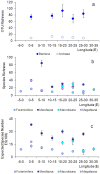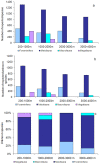Deep-sea biodiversity in the Mediterranean Sea: the known, the unknown, and the unknowable
- PMID: 20689848
- PMCID: PMC2914020
- DOI: 10.1371/journal.pone.0011832
Deep-sea biodiversity in the Mediterranean Sea: the known, the unknown, and the unknowable
Abstract
Deep-sea ecosystems represent the largest biome of the global biosphere, but knowledge of their biodiversity is still scant. The Mediterranean basin has been proposed as a hot spot of terrestrial and coastal marine biodiversity but has been supposed to be impoverished of deep-sea species richness. We summarized all available information on benthic biodiversity (Prokaryotes, Foraminifera, Meiofauna, Macrofauna, and Megafauna) in different deep-sea ecosystems of the Mediterranean Sea (200 to more than 4,000 m depth), including open slopes, deep basins, canyons, cold seeps, seamounts, deep-water corals and deep-hypersaline anoxic basins and analyzed overall longitudinal and bathymetric patterns. We show that in contrast to what was expected from the sharp decrease in organic carbon fluxes and reduced faunal abundance, the deep-sea biodiversity of both the eastern and the western basins of the Mediterranean Sea is similarly high. All of the biodiversity components, except Bacteria and Archaea, displayed a decreasing pattern with increasing water depth, but to a different extent for each component. Unlike patterns observed for faunal abundance, highest negative values of the slopes of the biodiversity patterns were observed for Meiofauna, followed by Macrofauna and Megafauna. Comparison of the biodiversity associated with open slopes, deep basins, canyons, and deep-water corals showed that the deep basins were the least diverse. Rarefaction curves allowed us to estimate the expected number of species for each benthic component in different bathymetric ranges. A large fraction of exclusive species was associated with each specific habitat or ecosystem. Thus, each deep-sea ecosystem contributes significantly to overall biodiversity. From theoretical extrapolations we estimate that the overall deep-sea Mediterranean biodiversity (excluding prokaryotes) reaches approximately 2805 species of which about 66% is still undiscovered. Among the biotic components investigated (Prokaryotes excluded), most of the unknown species are within the phylum Nematoda, followed by Foraminifera, but an important fraction of macrofaunal and megafaunal species also remains unknown. Data reported here provide new insights into the patterns of biodiversity in the deep-sea Mediterranean and new clues for future investigations aimed at identifying the factors controlling and threatening deep-sea biodiversity.
Conflict of interest statement
Figures







Similar articles
-
Hydroids (Cnidaria, Hydrozoa) from Mauritanian Coral Mounds.Zootaxa. 2020 Nov 16;4878(3):zootaxa.4878.3.2. doi: 10.11646/zootaxa.4878.3.2. Zootaxa. 2020. PMID: 33311142
-
Large spatial scale variability in bathyal macrobenthos abundance, biomass, α- and β-diversity along the Mediterranean continental margin.PLoS One. 2014 Sep 16;9(9):e107261. doi: 10.1371/journal.pone.0107261. eCollection 2014. PLoS One. 2014. PMID: 25225909 Free PMC article.
-
The biodiversity of the Mediterranean Sea: estimates, patterns, and threats.PLoS One. 2010 Aug 2;5(8):e11842. doi: 10.1371/journal.pone.0011842. PLoS One. 2010. PMID: 20689844 Free PMC article. Review.
-
Large-scale distribution and activity of prokaryotes in deep-sea surface sediments of the Mediterranean Sea and the adjacent Atlantic Ocean.PLoS One. 2013 Aug 28;8(8):e72996. doi: 10.1371/journal.pone.0072996. eCollection 2013. PLoS One. 2013. PMID: 24039667 Free PMC article.
-
Ecological variables for developing a global deep-ocean monitoring and conservation strategy.Nat Ecol Evol. 2020 Feb;4(2):181-192. doi: 10.1038/s41559-019-1091-z. Epub 2020 Feb 3. Nat Ecol Evol. 2020. PMID: 32015428 Review.
Cited by
-
Two new species of Acanthocotyle Monticelli, 1888 (Monogenea: Acanthocotylidae), parasites of two deep-sea skates (Elasmobranchii: Rajiformes) in the South-East Pacific.Parasit Vectors. 2019 Oct 30;12(1):512. doi: 10.1186/s13071-019-3756-5. Parasit Vectors. 2019. PMID: 31666097 Free PMC article.
-
Mapping cold-water coral habitats at different scales within the Northern Ionian Sea (Central Mediterranean): an assessment of coral coverage and associated vulnerability.PLoS One. 2014 Jan 23;9(1):e87108. doi: 10.1371/journal.pone.0087108. eCollection 2014. PLoS One. 2014. PMID: 24466332 Free PMC article.
-
Fish Distribution and Habitat Complexity on Banks of the Strait of Sicily (Central Mediterranean Sea) from Remotely-Operated Vehicle (ROV) Explorations.PLoS One. 2016 Dec 9;11(12):e0167809. doi: 10.1371/journal.pone.0167809. eCollection 2016. PLoS One. 2016. PMID: 27936221 Free PMC article.
-
Bottom trawling and environmental variables drive the biodiversity of mediterranean demersal assemblages.Sci Rep. 2025 Jul 26;15(1):27188. doi: 10.1038/s41598-025-12258-2. Sci Rep. 2025. PMID: 40715241 Free PMC article.
-
Ecological role of benthic Vulnerable Marine Ecosystems (VMEs) indicator taxa on soft bottoms.Sci Rep. 2025 Jul 22;15(1):26654. doi: 10.1038/s41598-025-10243-3. Sci Rep. 2025. PMID: 40695913 Free PMC article.
References
-
- Gage JD, Tyler PA. Deep sea biology: A natural history of organisms at the deep-sea floor. Cambridge: Cambridge University Press; 1991. 504
-
- Snelgrove PVR. Getting to the bottom of marine biodiversity: Sedimentary habitats. BioScience. 1999;49:129–138.
-
- Grassle JF, Maciolek NJ. Deep-sea species richness: Regional and local diversity estimates from quantitative bottom samples. Am Nat. 1992;139:313–341.
-
- Etter RJ, Grassle JF. Patterns of species diversity in the deep sea as a function of sediment particle size diversity. Nature. 1992;369:576–578.
-
- Blake JA, Grassle JF. Benthic community structure on the US South Atlantic slope off the Carolinas: Spatial heterogeneity in a current-dominated system. Deep Sea Res II. 1994;41:835–874.
Publication types
MeSH terms
LinkOut - more resources
Full Text Sources

